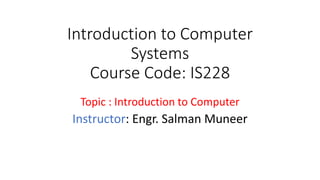
Introduction to Computer by engr salman muneer.pptx
- 1. Introduction to Computer Systems Course Code: IS228 Topic : Introduction to Computer Instructor: Engr. Salman Muneer
- 2. What is Computer? A computer is an electronic machine that collects information, stores it, processes it according to user instructions, and then returns the result.
- 3. What is the importance of computer? • Computers are important because they used in every field like engineering, medical, science, agriculture, education, banking, entertainment and business etc. • Computer can do complex tasks and calculations fast, effectively and accurately. • Computers are mostly used to create books, posters, magazines, and newspapers. • For saving huge data for longer time. • For security purpose.
- 4. What is history of Computer? • Father of computer is Charles Babbage. • 1st Generation (1940 to 1956) Punch cards in Abacus For example: Electronic Numerical Integrator and Computer(ENIAC), Universal Automatic Computer I (UNIVAC-1), Electronic Discrete Variable Automatic Computer (EDVAC). • 2nd Generation (1957-1963) Transistors For example: IBM 1620, IBM 7094, CDC 1604, CDC 3600. • 3rd Generation (1964-1971) Integrated Chips (IC) For example: the IBM-360 series, the Honeywell-6000 series, and the IBM-370/168. • 4th Generation (1971-1980) Microprocessor For example: STAR 1000, PDP 11, CRAY-1, CRAY-X-MP, and Apple II. • 5th Generation (1980- Now) ULSI (Ultra Large-Scale Integration) technology For example: IBM, Pentium, Desktop, Laptop, Notebook.
- 11. Types of Computer Computers can be classified in different ways as shown below: 1) Classification by processing 2) Classification by purpose 3) Classification by power and size/configuration/computing power 1) Classification by processing: This is by how the computer represents and processes the data. I) Digital Computers II) Analog Computers III) Hybrids Computers I) Digital Computers: are computers which process data that is represented in the form of discrete values by operating on it in steps. Digital computers process data represented in the form of discrete values like 0, 1, 2. They are used for both business data processing and scientific purposes since digital computation results in greater accuracy. II) Analog Computers: are used for scientific, engineering, and process-controlled purposes. Outputs are represented in the form of graphs. Analogue computers process data represented by continuous physical variables and output physical magnitudes in the form of smooth graphs. III) Hybrid Computers: are computers that have the combined features of digital and analog computers. They offer an efficient and economical method of working out special problems in science and various areas of engineering.
- 12. Types of Computer (Cont..) 2) Classification by purpose: This is a classification by the use to which the computer is put. I) Special Purpose Computers II) General Purpose Computers I) Special purpose computers: Special purpose computers are used for a certain specific function e.g. in medicine, engineering, manufacturing. II) General purpose computers: General-purpose computers can be used for a wide variety of tasks e.g. accounting, word processing.
- 14. Types of Computer (Cont..) 3) Classification by power and size/configuration/computing power: Computers can be broadly classified by their speed and computing power. I) Personal Computer (PC) II) Workstation III) Mini Computer IV) Main Frame V) Super Computer I) Personal Computer: It is a single user computer system having moderately powerful microprocessor. For example, Desktop computer, Laptop, Tablet. II) Workstation: It is also a single user computer system which is similar to personal computer but have more powerful microprocessor. For example, an average-powered computer connected to a larger network. III) Mini Computer: It is a multi-user computer system which is capable of supporting hundreds of users simultaneously. IV) Main Frame: It is a multi-user computer system which is capable of supporting hundreds of users simultaneously. Software technology is different from minicomputer. V) Super Computer: It is an extremely fast computer which can execute hundreds of millions of instructions per second.
- 16. What are the advantages of computer? 1) High Speed Computer is a very fast device. The computer has units of speed in microsecond, nanosecond, and even the picosecond. It is capable of performing calculation of very large amount of data. 2) Accuracy Computers perform all jobs with 100% accuracy provided that correct input has been given. 3) Connects you to the Internet Connecting a computer to the internet unlocks its full potential. Once connected, your choices and available options, as far as information goes, are almost limitless. It can do repeated work with same speed and accuracy. 4) Versatility A computer is very flexible in performing the jobs to be done. This machine can be used to solve the problems related to various fields. At one instance, it may be solving a complex scientific problem and the very next moment it may be playing a card game.
- 17. Advantages of computer (Cont..) 5) Reliability A computer is a reliable machine. Modern electronic components have long lives. Computers are designed in such a way that maintenance is Easy. 6) Automation Automation means ability to perform the given task automatically. Once a program is given to a computer i.e. stored in computer memory, the program and instruction can control the program execution without human interaction. 7) Reduction in Paper Work The use of computers for data processing in an organization leads to reduction in paper work and results in speeding up a process. As data in electronic files can be retrieved as and when required, the problem of maintenance of large number of paper files gets reduced.
- 18. Disadvantages of Computer 1) No I.Q A computer is a machine that has no intelligence to perform any task. Each instruction has to be given to a computer therefore a computer cannot take any decision on its own. 2) Dependency It functions as per a user’s instruction, so it is fully dependent on human being. 3) Cost Computer is expensive. 4) Health Issues More Screen time may affect your eye eyesight.